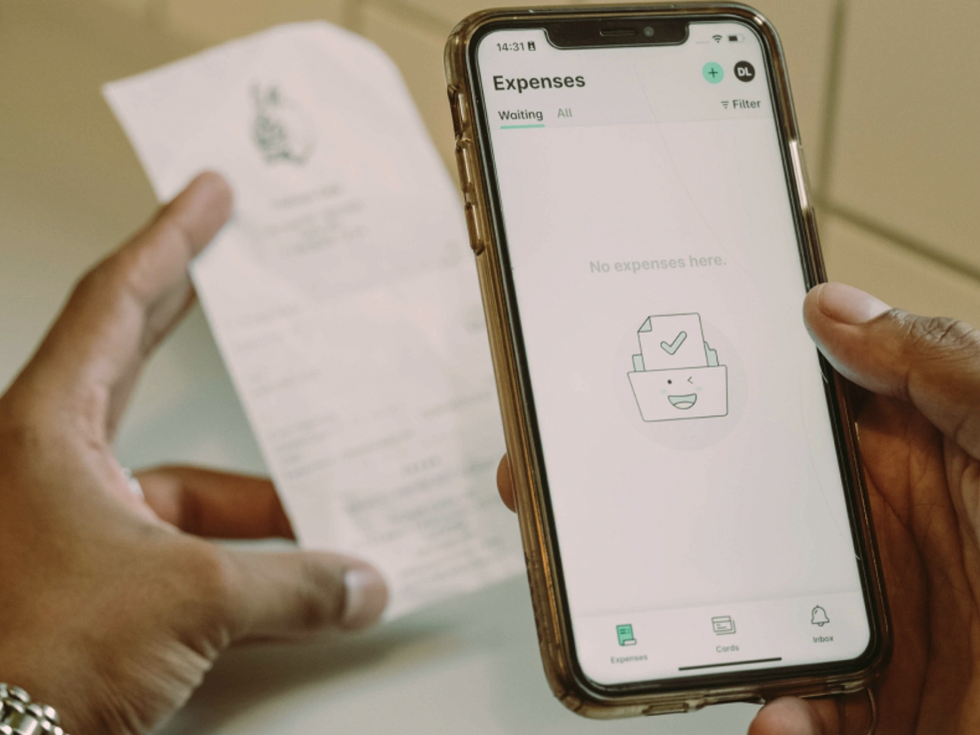
Smart data extraction made simple with OCR technology



Imagine a world where your business can glide effortlessly through mountains of paperwork, converting each handwritten scribble or printed line into digital gold. That's the power of Payhawk's OCR technology, transforming tedious manual data entry into a swift, automated, time-saving, insight-boosting process.
By submitting this form, you agree to receive emails about our products and services per our Privacy Policy.
Have you ever noticed how your eyes sometimes glide over words without picking up their meaning? It happens to the best of us. It’s almost impossible to read every word on a page, article, or book every single time. Why? Because it usually takes way too long — and that’s without the added eye strain and effort of data entry.
Fortunately, OCR technology has revolutionised data scanning and capture, removing manual reading and entry ‘from the picture’. Utilised across different industries, OCR technology is vital in processing paper forms through automation, including credit card receipt reconciliations and other data processes.
What is Optical Character Recognition (OCR)?
OCR converts handwritten or printed material (text) into machine-readable formats. Many companies and individuals use OCR software to convert paper documents into digital assets. This digitisation allows them to be indexed, stored electronically, and manipulated with software tools such as word processors.
Discover spend management technology that saves you time & confusion.
OCR technology has been around since the 1970s and has become increasingly sophisticated. Early versions could recognise isolated characters but not complete words, while modern versions can recognise words and even paragraphs.
Examples of OCR include:
- Scanning documents into PDFs for archiving purposes
- Creating searchable databases from pages of books
- Converting handwritten notes or drawings into typed text that can be edited and saved as digital files
How does OCR work?
OCR software breaks down an image into its features — lines, curves, and dots — and then compares them with similar features in a database of known characters. If there’s a match between the unknown feature and the one in the database, then the program will guess what letter it thinks it sees in that particular spot on the page. If there are multiple possibilities for each spot on the page, then the program will use statistical analysis methods to decide which letter it thinks is most likely correct.
The first step in OCR is scanning. The next step involves analysing the image's visual content and converting it into an editable form, including segmentation, layout analysis, isolation, and recognition.
Segmentation involves identifying individual characters within the scanned image and isolating them from each other by using bounding boxes or coordinate axes.
Layout analysis involves determining the placement of each character relative to one another so that the OCR can recognise it individually later. And isolation refers to identifying which parts of the image contain characters to be processed separately from other parts, such as background noise or photosensitive material like watermarks.
What are the benefits of OCR?
Efficiency
Scanning documents is faster and more accurate. When you use OCR technology for paper form processing, it takes less time to complete each task because you don't have to type in each piece of information from each document manually. You scan in the pages and let the software do all the work for you. You can convert a stack of unsearchable paper into a digital file that's easy to search, store, and share.
Accuracy
You make few-to-zero errors when converting documents to text. OCR software helps you avoid mistakes and uses advanced algorithms to recognise characters in images, even when distorted or partially obscured. The result is a high-quality digital representation of your document that you can easily share with others.
Plus, accurate receipt capture can save you thousands when it comes to spend management. Take German automotive company ATU, for example, who saved 2 million euros in VAT reclaims in just a year by capturing and correctly categorising their receipts.
Security
By converting documents into searchable PDFs, secure networks and online portals can use them — without the risk of unauthorised access. This added security makes it easier for users to collaborate on important projects and access documentation when they need it most.
Searchable
OCR allows you to search and index documents that aren't searchable by traditional means (e.g., PDFs). This is useful if you want to find all mentions of a particular word or phrase in multiple documents or locations on a web page.
Modifiable
OCR software allows you to edit scanned text (and sometimes images) after converting it into digital data. You can also use this tool to convert printed text into machine-readable text or even into speech, which is useful for converting books into ebooks and other types of textual content into more accessible formats.
Storable
OCR software allows you to store text in digital formats to retrieve them later easily. This way of storing data is helpful for those needing access to large amounts of information as they don't have to carry physical copies everywhere they go.
Translatable
OCR can translate documents into different languages without manually translating each word or phrase. The automated translations make it easier for companies that want to expand into foreign markets because all they need to do is create an English version of their website and then run it through OCR so that visitors from other countries can read it in their native language.
Why OCR data extraction outperforms manual methods
OCR (Optical Character Recognition) data extraction stands out as a superior alternative to manual data entry methods, primarily due to its efficiency, accuracy, and speed. Unlike manual methods that are time-consuming and prone to human error, OCR technology automates the process of converting various types of documents, such as invoices, receipts, and forms, into editable and searchable digital data.
Components of OCR
The main components of an OCR system are:
- Scanner — A scanner scans the document and converts it into an electronic image so you can store it on a computer or database.
- Recognition component — The recognition component converts the electronic image into a text file using image processing techniques such as pattern matching and feature extraction.
- OCR software — The OCR software takes the output from the recognition component and stores it in a format that other applications on your computer (e.g., Microsoft Word) can use.
How does OCR technology benefit spend management in SMBs and large enterprises?
Faster reconciliation: You can use your OCR software to scan batches of transactions at once instead of having to enter them manually one by one. This reduces the time it takes to reconcile your cards, which is especially valuable if you have a lot of card transactions.
Reduced errors: When you scan in batches, there’s less room for human error because the process is more automated. And because the data is already in text format, OCR also helps remove some mistakes (like typos) that would otherwise be introduced during manual entry.
No manual work: With OCR software, humans don’t need to go through each transaction and type out the details — the software does everything for you. This reduces error and saves time without sacrificing accuracy or quality control over how data is entered into reports or budgets.
Supports proper budgeting: OCR helps with budgeting because it allows you to work more efficiently and spend less time on data entry — which means more time for other projects like training employees, updating software systems, etc.
How to use OCR for data capture in your business
When running a business, one of the most important things you need to do is ensure you have all your data accurately entered into your systems. Data accuracy can be a real headache for finance teams and takes up a lot of time. But it doesn't have to be this way. With the right systems in place, it can be as easy as taking a photo or uploading a receipt.
At Payhawk, we create our own machine-learning algorithms in-house on top of Google's OCR. And based on the learnings of tens of thousands of invoices, it will find and extract the relevant invoice information for you. Furthermore, you can teach the system where to look for information on specific invoices.
How does OCR work for my company cardholders?
Our software solution consists of the OCR tool, which automatically extracts data from any image or PDF document and converts it into a digital format (and transfers it to your accounting software). This means that your cardholders don’t have to spend hours rekeying their data when they make payments – they spend with their Payhawk card at any merchant location or online store and take a photo of the receipt or upload an invoice.
We then automatically extract all the relevant information, including name, address, payment amount, and more, so there’s no tedious data capture for you or your finance team colleagues.
OCR-supported card reconciliation in real time
The painful truth is that most businesses still use manual or sub-par automation processes for reconciliation and reporting, which means they lack visibility into their accounts receivable metrics. They still have to wait until the end of the month, reconcile all their transactions, and then make sure they match up with what the bank says they should be. This lack of visibility puts them at risk of losing money and missing vital cash flow visibility as they don't know if their transactions are complete or not.
The best time to do reconciliations is in real time. With our OCR-supported card reconciliation system, you can see all your transactions instantly and get a clear picture of your business anytime during the day or week. You can reconcile your transactions in real time, as they happen, and you can be confident that your numbers are accurate.
Simplifying data extraction with cutting-edge OCR technology
As your business goes global, so should your finance and accounting systems. The demand for OCR technology is growing as more businesses realise its benefits. The ability to extract data from multiple sources, convert it into a usable format, and then import it into a finance and accounting system is essential in today’s global marketplace.
Data capture and entry is time-consuming and expensive if done manually. But with the right OCR technology, your business can automate this process ― optimise your productivity and save valuable time.
At Payhawk, our spend management solution, featuring OCR technology, allows companies to improve productivity and accuracy while reducing errors and speeding up reconciliation. It’s easy to use and has best-in-class integrations with multiple accounting software options and ERPs, including NetSuite, Xero, and Microsoft Dynamics.
Learn how to automate processes with just a few clicks and advance your business insights. Book a demo today.
Trish Toovey works across the UK and US markets to craft content at Payhawk. Covering anything from ad copy to video scripting, Trish leans on a super varied background in copy and content creation for the finance, fashion, and travel industries.
Related Articles


How to keep track of business expenses: Best practices for UK businesses

